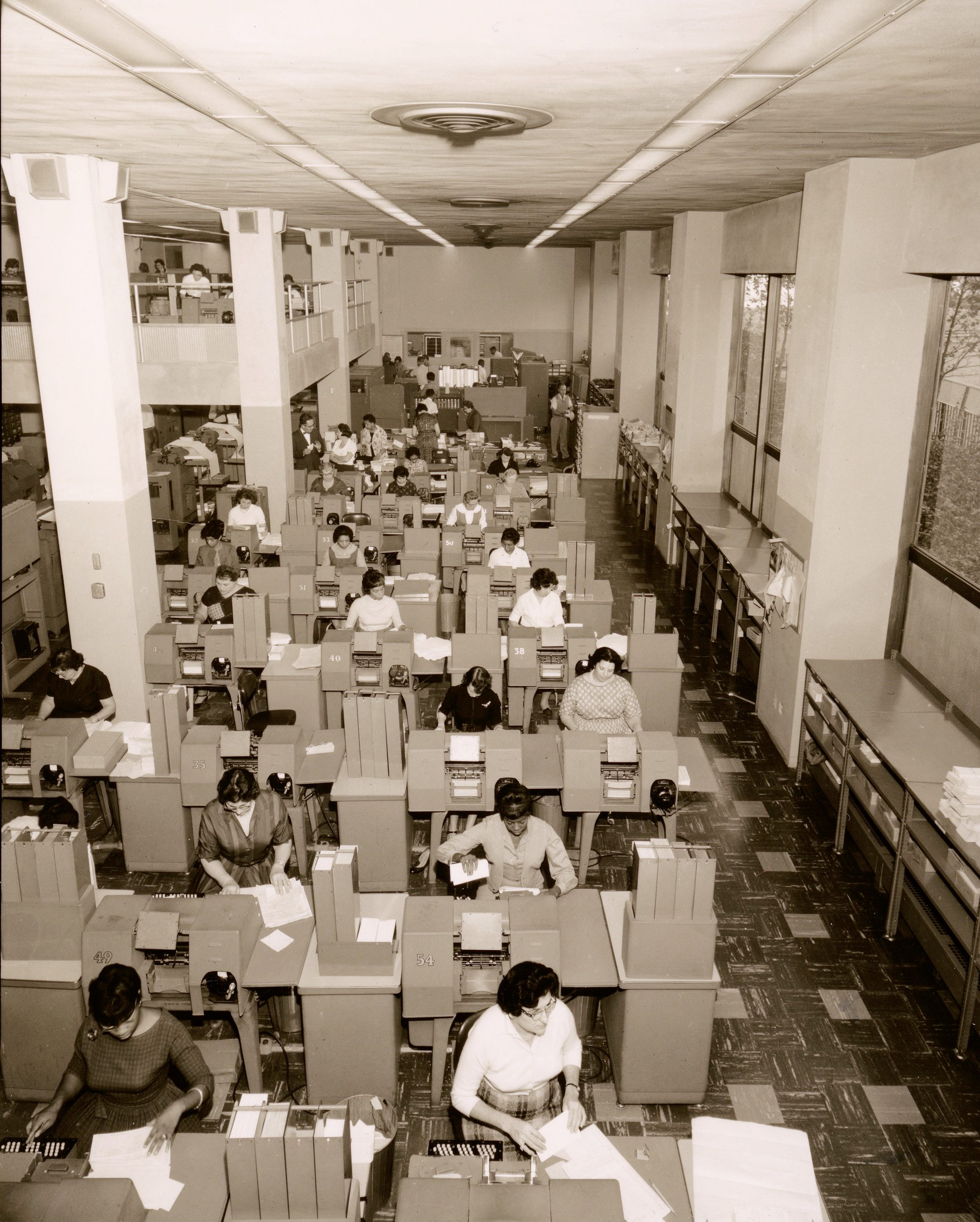Inside the Brooklyn Building that Held the Subway’s Secrets

Rendering from the Board of Transportation Annual Report, 1949. (Courtesy of the New York Transit Museum)
If there were a contest for New York City’s least favorite building, 370 Jay Street in downtown Brooklyn would almost certainly be in the running. “Blight,” “derelict,” and “eyesore” are some of the nicer words politicians and journalists have used to describe the quality of the former transit headquarters. The Brooklyn Eagle shortlisted it as one of the borough’s ugliest buildings. And, as a 2012 New York Times piece about its renovation noted, “it is pretty much impossible to love the Transportation Building.”
Even a casual visitor can understand why it gets a bad rap. The 13-story limestone structure, situated just above the Jay Street-MetroTech subway station, has been wrapped in scaffolding for years–and its blocky, modernist design gives it a soul-crushing bureaucratic vibe. But bureaucracy was precisely what the building was designed for–and exactly what its early cheerleaders loved about it.
“Not a cathedral of commerce, not a temple of advertising, not a palace of municipal power: just a grouping of offices arranged for the efficient dispatch of administration,” wrote Lewis Mumford, the city’s pre-eminent architecture critic, in the April 25, 1953 edition of the New Yorker.
And while the greyish building isn’t much to look at, inside, it’s a bureaucratic Rube Goldberg machine. Called the Transportation Building, it was the epicenter of the city’s transit infrastructure and housed thousands of employees who kept track of everything from the Subway Command Center, a long console that helps dispatchers keep track of trains throughout the system, to public-facing services like the lost and found. In fact, 370 Jay Street has what some transit experts call a secret history–one that includes a hidden money elevator, top-secret passageways and an infamous heist.

The data processing rooms which recorded the operations of the subway system, 1957. (Courtesy of the New York Transit Museum)
One of the recurring challenges of running New York’s transit system was managing the safe collection of millions of dollars worth of fares at each station. “Initially when they collected all the money from the stations they had to use armored cars, which was a little complicated, a little unsafe,” explains Brigid Harmon, Curator at the New York Transit Museum.
The designers of 370 Jay Street had an idea: Take advantage of the subway lines below the new headquarters and send trains to collect the cash that accumulated at each station. And that’s exactly what they did. Teams of armed guards went from station to station, loading up the fares and taking them through secret passageways and elevators up to what workers called “the Money Room” on the second floor of the building.
But that plan wasn’t foolproof. One Saturday morning in 1979, there was a planned blackout at 370 Jay as part of a drill. Even though extra guards were posted at the Money Room, the robbers got their way. “Monday morning, people walk in, they open the vault, and $600,000 is missing,” Harmon says. All of the ten-dollar bills were gone, 120 pounds worth.
Officials scrambled to figure out what happened. They found an escape hole in the wall of the adjacent women’s bathroom and tracked the thieves to a hotel room in New Jersey, where they found an empty bag marked “Transit Authority.” After an initial investigation that reportedly focused on someone inside the transit agency, officials eventually put out a $25,000 reward to catch the suspects. But they were never caught and the money was never returned.
Despite the heist, the money train survived until 2006. The decision to abandon that system was largely logistical. Automated MetroCard machines simply took longer to empty than old-fashioned bags of cash, which left the money train idling in the station and held up normal train service. The MTA returned to armored cars–and the days of 370 Jay Street were numbered.

By 1961, an “Information by Automation” machine, called a Directomat was installed in the lobby. (Courtesy of the New York Transit Museum)
The elaborate fare collection apparatus wasn’t the only way 370 Jay Street’s form mirrored its function. It had entire rooms dedicated to phone equipment with people who manually connected calls. It housed a lost and found, which saw hundreds of umbrellas, tubas, a pheasant, and a jar full of ashes labeled “my dear wife Ada.” There was a department devoted to complaints about everything from smells to rider behavior–and a room for photo reproduction equipment used to document the transit system’s history.
Though many of those same functions technically still exist within the MTA, most don’t require rooms full of people manually laboring over phone equipment or piles of documents. By 2006, the MTA largely vacated the building and returned to Manhattan.

Employees of the Photography Reproduction Department, 1964. (Courtesy of the New York Transit Museum)
“The building was built with a very particular reason and a number of those reasons changed drastically once we hit the 21st century,” says the transit museum’s Harmon, who led a tour of a new exhibit devoted to the history of 370 Jay Street that will run through May. “You didn’t need a room this big–you didn’t need that much data processing. These were rooms full of telephone equipment.”
By 2017 the building is scheduled to be transformed again, this time by New York University, which plans to house a global center for science, technology and education there. And while the university plans to renovate 370 Jay Street, it is vowing to keep many of its architectural features in tact. That might mean decades more of intentionally bureaucratic architecture anchoring downtown Brooklyn, but if incoming students look closely enough, they might just find a secret passageway to its past.










Follow us on Twitter to get the latest on the world's hidden wonders.
Like us on Facebook to get the latest on the world's hidden wonders.
Follow us on Twitter Like us on Facebook